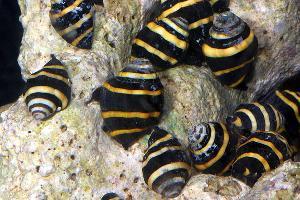Bumble Bee Snail - Pusiostoma (engina) mendicaria
Bumble bee snails are small stunning snails with a striped black and yellow pattern that resembles the pattern of a bumble bee – hence the name. They originate from the Indo-Pacific region, but can also be found in the waters of Florida. Many of the snails in the trade are collected off the Marshall Islands, a Micronesian nation of islands in the middle of the Pacific Ocean. Bumble bee snails can sometime grow to be 1 in (2.5 cm) but usually only grow to half that size. The bumble bee snail is readily available in the aquarium trade and usually costs between $2 and $3.
This stunning nocturnal snail is unfortunately relatively shy and is only seldom seen out during the day. The Bumble bee snail is easy to care for and quite hardy. They are however sensitive to nitrate, copper and rapid changes in water conditions (even small ones). They should due to their sensitivity to rapid water changes be acclimatized to new tanks through drop acclimatization over a period of at least 2 hours. They prefera specific gravity of 1.023 - 1.025, pH 8.1 - 8.4, dKH 8-12 and temperature 72 - 78° F / 22-25.5° C. Calcium levels in the aquarium should be kept between 350 and 450 ppm to ensure proper shell growth and quality. They do best in aquariums with a lot of live rock and a deep sand bed. This species burrows a lot in the sand and will therefore help keeping the sand bed oxygenated.
Bumble bee snails are an ideal addition to the cleaning crew for any tank as they will eat any uneaten food, decaying matter and most algae species. They can due to their small size get into very small cavities in the setup and clean them. Bumble bee snails are suitable for reef tanks but are not 100% reef safe as they will eat zooanthids and polyps if they are not provided with enough food. In the average aquarium this isn't a problem and the snails find enough food. If your aquarium contain little to eat it is recommended that you supplement the diet of your snails by feeding them at night. They will accept most foods but love dried sea weed rapped around a rock placed on the bottom of the tank. The diet supplement should also contain meaty food such as mysis shrimp.
It is possible to breed bumble bee snails in the aquarium, but bumble bee snail breeding is very difficult and only seldom succeeds in aquariums. It can be assumed that ample supply of food increases the chance of spawning. Reports have also indicated that an increase in water temperature, exposure to natural light and the creation of small areas without current can help trigger this species to spawn.

